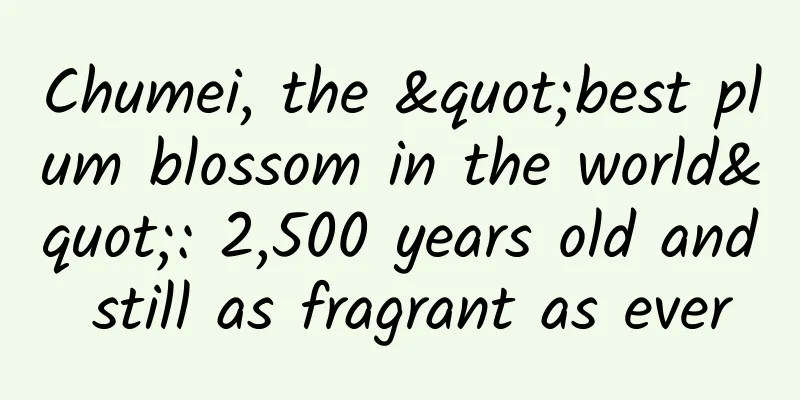Chumei, the "best plum blossom in the world": 2,500 years old and still as fragrant as ever

|
Two days ago, I heard that the Chu plum blossoms in Zhanghua Temple were still in bloom, so I invited my friends to go to Shashi, Jingzhou, Hubei to take a look. The five ancient plum trees in my country: Chumei, Jinmei, Suimei, Tangmei and Songmei, are all in ancient temples. Chumei, also known as Zhangtaimei, is said to have been planted during the reign of King Ling of Chu more than 2,500 years ago and is known as the "best plum in the world". Among the five plum trees, Chumei blooms the earliest and has the best fragrance, because it is "not a plum", but a wintersweet of the Chimonaceae family, known as yellow plum in ancient times. The Chu Palace on the water has become a thousand-story temple on the stage Yingmeixiang Temple blooms in the first spring in front of the mountain ——Couplet of Zhanghua Temple in Jingzhou Entering the temple, following the scent, we soon saw two clumps of wintersweets in front of the main hall, one ancient and one new, both in bloom, with a fragrant aroma. Next to the ancient plum tree, there is a 1,400-year-old Tang apricot tree. In the temple, there is also an ancient agarwood well that is said to have been left behind by the Zhanghua Palace. Thousands of years have passed, and the stars have moved. Standing in front of the ancient tree and well, all kinds of questions and associations come to mind: Who planted this tree? Why has it survived all the disasters? When and who smelled the fragrance of this flower? Cleanse your mind and free it of dust, and you will smell the subtle fragrance while sitting. Then I realized that the Fengjian was used to chop off the nose of the man from Ying. ——Ode to Wintersweet by Zeng Ji, Song Dynasty Tracing the origin of wintersweet, at least 1,000 years of its 2,500-year history is "untraceable". The reason is that although wintersweet is native to China, it was an unknown small miscellaneous tree in the countryside of Bachu before the Song Dynasty, or was confused with "plum". It was not until the Yuanyou period of Song Zhezong that it was noticed and vigorously promoted by Huang Tingjian and Su Shi, and then it began to "really have its own name": "Because it blooms at the same time as plum blossoms, and has a similar fragrance, and its color resembles honeycombs, it is named wintersweet." "It has a similar fragrance to plum blossoms, and also has five petals, similar to the ones made by women twisting wax, so people in Beijing and Luoyang call it wintersweet." The ancients regarded plum blossoms in the Rosaceae family as a "must-have" for oil, salt, sauce and vinegar. "If you want to make soup, you should use salt plums." You can enjoy the flowers and eat the fruits at the same time. In contrast, wintersweets are much more "useless". The fruits have no pulp and are poisonous. The biggest use is that they are beautiful and fragrant, and they bloom in winter, and the colder it is, the more fragrant they are. Plum blossoms are afraid of cold, and they can only bloom when the average temperature reaches 6-7 degrees Celsius, and they often bloom around the beginning of spring. Wintersweets are more cold-resistant and have a longer flowering period. The flowering period of the plum blossoms in Zhanghua Temple is from the eighth day of the twelfth lunar month to the early spring of the following year. This kind of "useless beauty" and "frosting posture" conforms to the aesthetics of the Song people, who wrote a large number of poems for wintersweet, and also gave rise to a variety of "Song-style life aesthetics" such as tasting incense, vase inserts, and smoked tea. I like Huang Tingjian's sentence "People and wintersweet illuminate each other" the most. When the sun is cold and the wind is high, the world is bleak, and suddenly a full tree or a branch of wintersweet catches your eye, your mood suddenly becomes beautiful. Wintersweet is called wintersweet in English, which is really appropriate. Many people in the Song Dynasty were crazy about wintersweet, such as Huang Tingjian, Fan Chengda, Wang Shipeng, Zhang Heng, Chen Shidao, etc. Huang Tingjian lived in Jingzhou for nearly a year. Fan Chengda traveled to Jingzhou with Xin Qiji on his way back home. In his travel notes, he mentioned that "Zhanghuatai is in a wild temple outside the city." I wonder if they saw this wintersweet, which was more than 1,000 years old at that time? (The author Ni Yun is a naturalist and freelance writer) Further reading Thinking of the past under the plum tree: I no longer see the slender waist of Chu The flowers in Luofu Dream are warm and wild, and the old plants are still fragrant. Who planted it and in what generation could make the streets full of the fragrance of spring snow? ——Ode to the Plum Blossoms at Zhangtai by Luo Chaowei, Qing Dynasty Looking back to the past, when the "No. 1 Terrace in the World" - Zhanghua Terrace, the temporary palace of King Ling of Chu, was completed, it became a textbook example of extravagance and waste. King Ling of Chu was the originator of the "A4 waist" aesthetic and body self-discipline. He "liked people with thin waists" and "many people starved to death" in the court and the palace. Later generations therefore called this palace terrace "Slim Waist Terrace" or "Slim Waist Palace". Zhanghua Temple was built in the second year of the Yuan Dynasty (1325), more than 1,800 years after the completion of Zhanghua Terrace. Is Zhanghua Temple the site of Zhanghua Terrace? Where was the original site of Zhanghua Terrace? Historians have different opinions, including Zhanghua Temple in Jingzhou, Longwan in Qianjiang, and Zhoulaozui in Jianli. Jingsha is located in the ancient Yunmengze, at the meeting point of rivers and lakes, and has many high platforms: Zhuangwang Platform, Fan Ji's Dressing Platform, Zhuoying Platform, Luomao Platform, Jiangzhang Platform, Dianjiang Platform, Ziyun Platform, Fengtai, Meitai, Ganma Platform, Qinglong Platform... Wise men like Sun Shuao, the prime minister of Chu, built platforms to construct water conservancy projects, prevent floods and cope with disasters. Ordinary people built platforms according to their surnames and lived in settlements, with each platform representing one surname. The largest residential platform in Shashi is Zhangjiatai, where Zhang Juzheng, the chief minister of the Ming Dynasty, was born and raised. During the Ming and Qing Dynasties, there was a wide water area around Zhanghua Temple, originally named Zhangtaiyuan and Heyeyuan. Later, it was renamed Taishiyuan to commemorate Zhang Juzheng's achievements in flood control and river and lake dredging during his return to his hometown for recuperation. There is a high platform on the abyss, named Kanhuatai. |
<<: The more you lack something, the more you want to show for it. Why is this so?
>>: An asteroid may hit the Earth in 2032. Do humans need to save themselves? Experts: Don't worry.
Recommend
Android takes you to analyze ScrollView-imitation QQ space title bar gradient
[[190235]] introduction Today we are going to stu...
How to earn 30,000 yuan a month by selling iPads on Xianyu
Boss Feng currently makes a stable $30,000+ per m...
Behind the "price increase" of domestic smartphones, has the "low-price era" really passed?
At the beginning of the new year, domestic smartp...
2020 App Purchase Report
Introduction According to the data, in October 20...
BMW's stake in BMW Brilliance increased to 75%, share adjustment to be completed in 2022
On October 11, the BMW Group announced that it wo...
Latest | Data rankings of 56 mainstream information flow advertising platforms!
The following is the latest traffic ranking of 56...
The bonus period of Douyin fans is coming, how can we take advantage of it?
Follow the flow , you will never go wrong. This s...
How to make your original articles full of useful information?
"Write articles with more substantive conten...
Apple fans want a big-screen iPhone, 1/4 say they have enough money
Analysis from RBC Capital Markets shows that consu...
Starting from the rectification of large-screen TV operations, China's color TV industry looks forward to 2024 on the cusp of technology
More than a decade ago, smart TVs were once very ...
Whether it is bidding or information flow, you can spend more money, but it must not be ineffective
If we talk about the two most popular traffic cha...
Is Baidu snapshot promotion useful? What is the annual package price?
Baidu snapshot promotion can also be called "...
Japanese volcano erupts four times in a week. Will Mount Fuji also...?
While the world's attention was still focused...
AARRR Model: Mastering Gamification User Growth Strategy (Part 1)
We need a set of operational plans based on the A...









